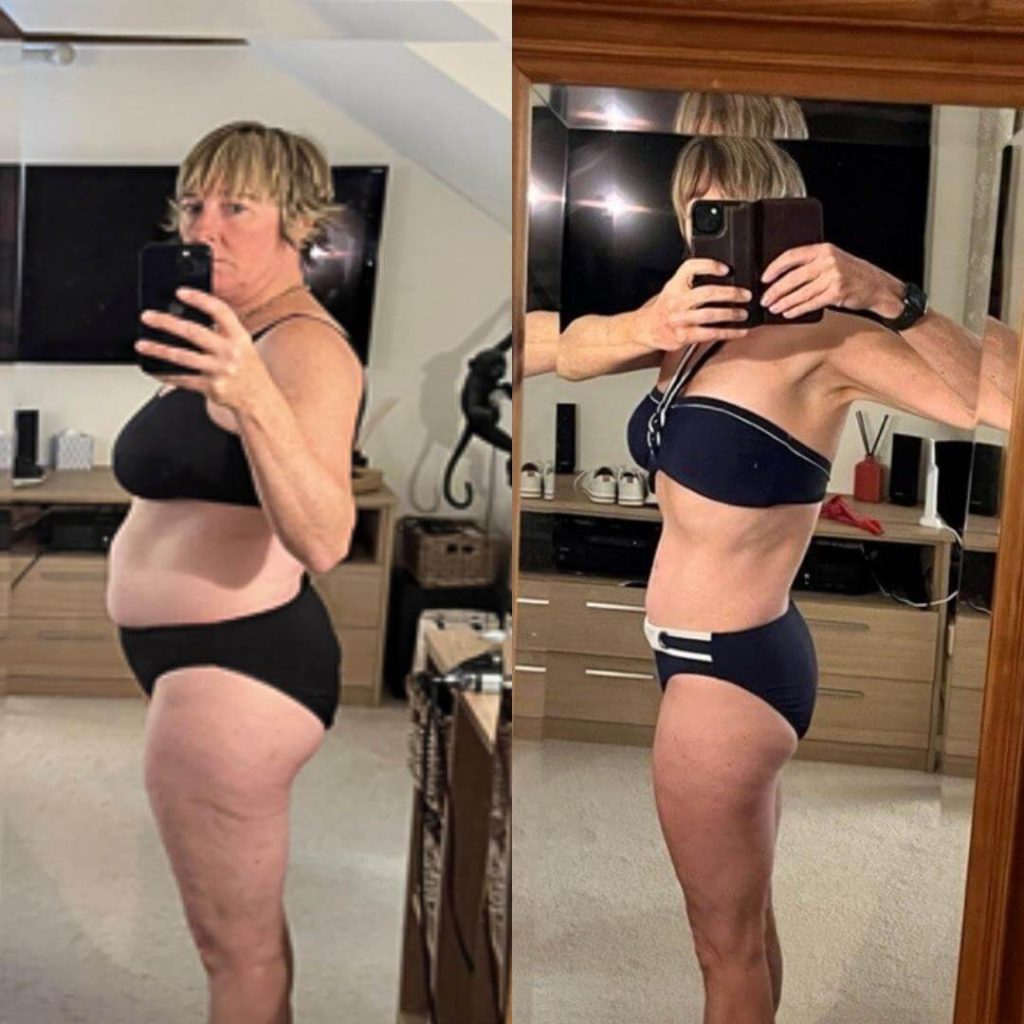Is exercise enough to lose weight? It’s a question many women ask, especially when they’ve been working out, eating well, and still feel stuck. If you’re in your 40s, 50s or 60s, you’ve likely noticed that what worked in your 20s just isn’t cutting it anymore.
You’re smart. You’ve spent most of your life looking after everyone else. But now the mirror feels unfamiliar, your clothes don’t fit right, and you’re wondering why you feel so tired. Even though you’re doing “all the right things,” the scale won’t budge.
The truth? Exercise alone is not enough to lose weight, especially in menopause. But the good news is: there’s a better way.
In this article, you’ll discover the science-backed reasons why traditional exercise might be failing you, what really works for women over 40, and how you can finally start seeing results, without running yourself into the ground.

Why Exercise Alone Doesn’t Lead to Weight Loss
While regular movement is great for your overall health, the reality is this: fat loss comes down to more than just “burning calories.”
One of the biggest myths in fitness is that you can “out-exercise” a poor diet or high-stress lifestyle. You can’t.
A hard 45-minute workout might burn 300–400 calories. But that’s the equivalent of one glass of wine and a couple of biscuits and unsurprisingly most of us eat that without thinking.
To make things worse, intense workouts often increase hunger and cravings, especially if you’re not fuelling your body properly. So many women end up exercising more, eating more, and feeling exhausted… but getting nowhere.
So if you’ve ever wondered, “What’s the point?”, you’re right to be sceptical. Exercise is important, but it’s not the full picture.
Why It’s Harder to Lose Weight Over 40
Once you reach your 40s, hormonal changes start to affect almost every aspect of your body. This can range from how you store fat to how well you sleep and recover.
In perimenopause and menopause, oestrogen levels drop, which leads to a natural slowing of metabolism and reduction in lean muscle mass. This means your body burns fewer calories at rest than it used to.
Cortisol, your stress hormone, also tends to be higher, especially if you’re balancing a demanding job, kids, ageing parents, and all the mental load that comes with midlife.
The result? Your body is more likely to store fat (especially around the middle), less able to recover from intense workouts, and more sensitive to sleep disruption.
All of which make fat loss harder, even if you’re “doing all the right things.”
That’s why your old go-to fixes like running, cutting carbs, or smashing it at the gym are no longer giving you results. Because they don’t work with your changing body. They fight against it.

“I was pleasantly surprised at how good I felt just a couple of weeks into the program and although I had initially signed up for 3 months, it spurred me on to join for a full year. I realised very quickly that my choice of foods and regular drinking of alcohol would have to change in the longterm to be able to see results. The diet makeover was a revelation, I’m now 10 kilos lighter, 3 dress sizes down and I feel AMAZING. Overall I feel less stressed, more confident and happy and am loving my slim physique!”
– Sarah (51), Trinity Client
What Actually Works for Weight Loss Over 40
Many women think they just need to “try harder.” But the problem isn’t you. It’s the plan you’re following. And it’s likely outdated.
Here’s what’s actually working for our clients inside Trinity Transformation, women in their 40s, 50s and 60s who are dropping 1–2 dress sizes in just 12 weeks, without starving themselves or living in the gym.
The Right Strategy To Lose Weight Over 40
So, if cardio isn’t the answer, what is? Here’s what’s working for our clients inside Trinity:
1. Strength Train 3–4 Times a Week
The foundation of fat loss over 40 is strength training, specifically LIST, or Low-Impact Strength Training. This form of exercise helps build lean muscle, which is your body’s most metabolically active tissue. The more muscle you have, the more calories your body burns, even at rest.
LIST is designed to be gentle on joints while still highly effective. It reduces inflammation, improves posture, strengthens bones, and helps flatten the stomach area by engaging your core during movement.
You don’t need to spend hours in a gym. Most of our clients work out from home, using a pair of dumbbells for 30 minutes, 3–4 times a week. It’s about training smarter, not harder.
2. Start Walking More
Walking is often underrated, but it’s one of the most powerful tools for fat loss when combined with other strategies, especially during menopause.
Unlike high-intensity workouts, walking lowers cortisol rather than increasing it. It improves insulin sensitivity, digestion, mood, and even sleep. And it helps you burn extra calories without spiking hunger or stress.
Most women we work with are shocked to realise they’re only walking 2,000 steps a day or less, especially if they’re working a desk job or tied up with back-to-back Zoom calls.
To start seeing results, aim to slowly increase your daily steps to 6,000–8,000.
That might look like a 10-minute walk after breakfast, 20 minutes after dinner, or a lunchtime stroll instead of scrolling your phone. You don’t need to reach 10,000 steps overnight, just build up gradually and consistently.
3. Increase Your Protein Intake
Protein becomes more important than ever as you age. It’s essential for maintaining lean muscle mass, which in turn helps you burn more calories and keep your metabolism firing.
It also keeps you fuller for longer, reducing the urge to snack on sugary or carb-heavy foods, which many women tend to crave more during menopause.
Most women eat far too little protein. To see a real difference, aim for around 30 grams per meal. That could be eggs or Greek yoghurt for breakfast, chicken or tofu in a salad for lunch, and salmon or lean beef at dinner.
If you’re on the go, a protein shake or boiled eggs make quick and easy options to help keep your protein intake high.
4. Get 7–9 Hours of Quality Sleep
Sleep is often the missing piece of the fat loss puzzle. Poor sleep leads to more cravings, higher cortisol, and less energy to make good decisions. Even one night of five hours or less can cause you to eat 300 extra calories the next day, enough to gain over two stone in a year if it becomes a habit.
To improve your sleep, start winding down earlier. Limit screens before bed, keep your bedroom cool and dark, and avoid caffeine after 2pm.
If hot flushes or insomnia are affecting you, those can often be improved with the right training and nutrition strategy too.
5. Create a Calorie Deficit That Works for You
To lose weight, yes, you do need to be in a calorie deficit. But that doesn’t mean eating like a bird or living off shakes and salads.
In fact, extreme dieting is one of the biggest reasons women over 40 struggle. It leads to bingeing, low energy, hormone disruption, and burnout. And worst of all, it makes your body more resistant to fat loss in the long run.
The goal isn’t to eat as little as possible. It’s to eat just enough to nourish your body, build lean muscle, and create a small, sustainable deficit.
For most women we work with, that means reducing calories slightly while improving food quality, eating more protein, cutting back on processed carbs, and making smart swaps that don’t leave you feeling deprived.
This is exactly what we coach inside Trinity. It’s personalised, balanced, and easy to stick to, because if it’s not sustainable, it simply won’t work.
6. Manage Your Stress Levels
High stress equals high cortisol, and that often leads to fat storage, especially around the belly. The frustrating thing is that even if you’re eating well and moving daily, stress can still block your progress.
Managing stress doesn’t mean quitting your job or living in a spa. But it does mean giving your body what it needs to recover.
That could be meditation, journaling, walking in nature, reading before bed, or even simply taking 10 minutes a day to breathe deeply and slow down.
Our most successful clients don’t just train well, they rest well too.
7. Try the WADS Approach to Reset
WADS stands for Wheat, Alcohol, Dairy, and Sugar, which are the four of the most common foods that disrupt hormones, spike cravings, and block fat loss.
They’re also the foods most women say they struggle to moderate.
The WADS reset is a simple 1–2 week phase where we remove these foods temporarily to give your body a break. It’s not forever. But this short reset can reduce bloating, improve digestion, balance hormones, and give you a huge motivation boost when you see the scale start to move again.
After the reset, we teach you how to reintroduce these foods occasionally, without falling back into old habits. This isn’t to be restrictive, it’s about resetting your relationship with food and breaking the cycle of cravings.
Most women lose 4–6 pounds in just two weeks during this phase, and more importantly, they feel better fast.
8. Flexible Eating for a Healthy Lifestyle
You don’t have to be perfect. Learn how to The idea that you need to be perfect to lose weight? Rubbish.
In fact, trying to be “perfect” is often what causes women to fail. One slip-up turns into a binge. One missed workout turns into giving up altogether.
That’s why we teach flexible eating. A way of eating that supports your goals without cutting out all the foods you love. There’s room for wine. Room for meals out. Room for chocolate.
It’s all about finding the right balance, not obsessing over every calorie.
Inside Trinity, we show you how to build meals that are simple, satisfying, and sustainable. You’ll learn how to eat well without tracking calories obsessively or weighing every gram of food.
9. Find a Community and Coach to Support You
Going it alone is hard. It’s even harder when your body isn’t responding the way it used to. That’s where coaching and community come in.
Inside Trinity, our clients aren’t left to figure it out on their own. They have expert coaches guiding them every step of the way, with personalised plans and real accountability.
And just as important, they’re surrounded by a supportive group of like-minded women on the same journey. Women who get what they’re going through and are lifting each other up. That connection makes a massive difference to long-term success.
10. Remember—It Takes Time
Long-term weight loss isn’t linear. You didn’t gain weight in one week, and you won’t lose it in one either. But when you’re following a plan that works with your body, not against it, the results add up quickly.

“Your weekly coaching calls helped me to learn to reprioritise and I have reduced my work load to concentrate on my own business. I would be working 6 days a week but now it’s more like 4 which is great. My head is clearer now. It took me a long while to give myself permission to allocate time for me for my workouts. I am now 10st and my work colleagues have noticed I no longer have a short fuse. I no longer believe myself to be a sugar-holic. My stress levels are well controlled. I have finally changed my job to concentrate on my own business. I am happier and I am a nicer person to be around.”
– Hayley Jackson (47), Trinity Client
How Trinity Can Help You Finally See Results
At Trinity, we’ve helped over 7,000 women lose 15–25 pounds, drop 1–2 dress sizes, and feel like themselves again, even after years of trying everything else. Our success rate? 97%.
Unlike generic diets or quick fixes, our approach is specifically designed for women over 40, going through the hormonal shifts of perimenopause and menopause.
We focus on smart, low-impact training. Nutrition that balances hormones, supports fat loss and reduces cravings. Real lifestyle changes that actually fit into a busy life. And most importantly, we provide coaching, support and accountability every step of the way.
This isn’t a “download and do it yourself” plan. It’s a proven system, built around you.
If you’re ready to stop spinning your wheels and finally see progress, we’re here to help.
Frequently Asked Questions
You might lose a small amount, but long-term fat loss usually requires a combination of exercise, balanced nutrition, good sleep, and stress management.
Is exercise enough to lose belly fat?
No. Belly fat is heavily influenced by hormones, stress, diet, and sleep. Exercise helps, but it’s not enough on its own.
Is it pointless to exercise without dieting?
Not pointless as exercise still improves health, but if fat loss is the goal, diet plays a much bigger role, especially after 40.
How much exercise should a 40 year old woman do?
Around 3–4 strength-based sessions per week combined with daily walking is a great place to start for fat loss and hormone balance.




